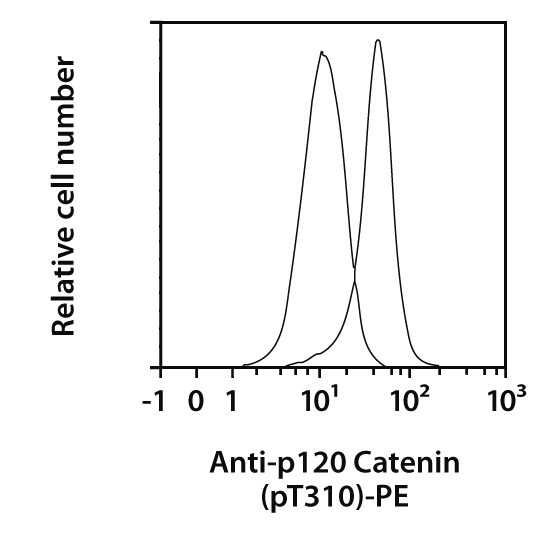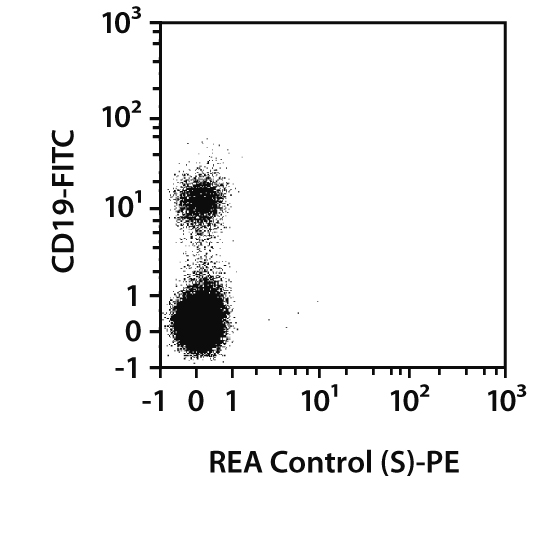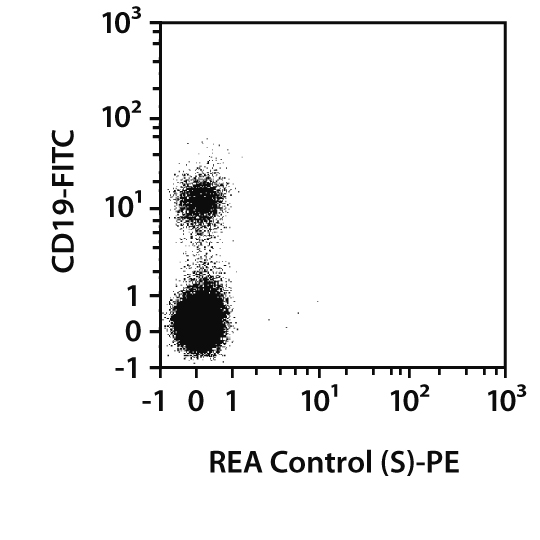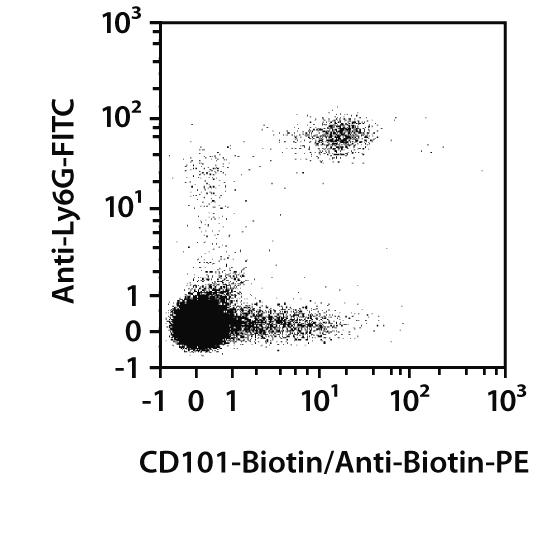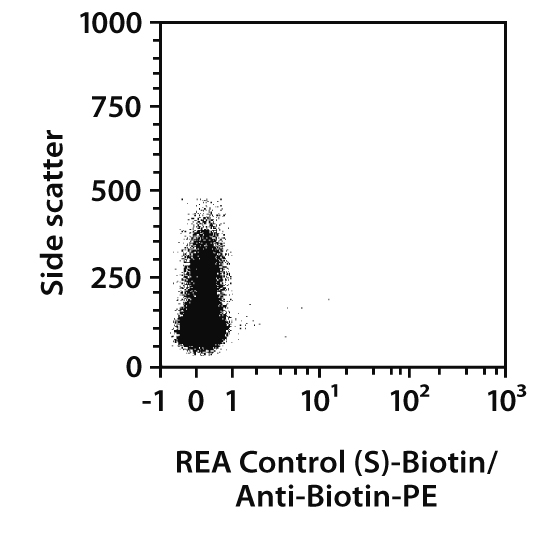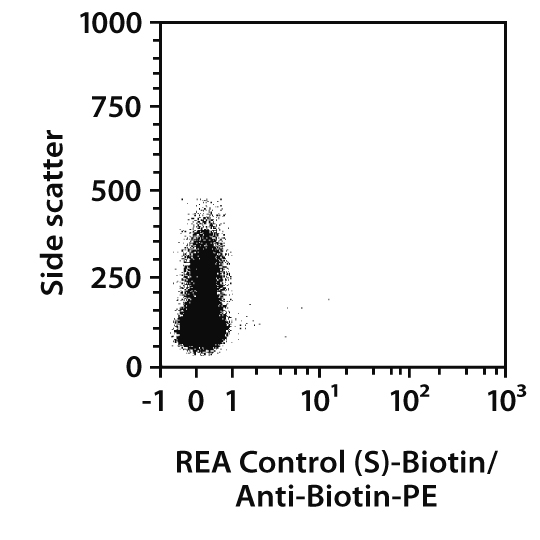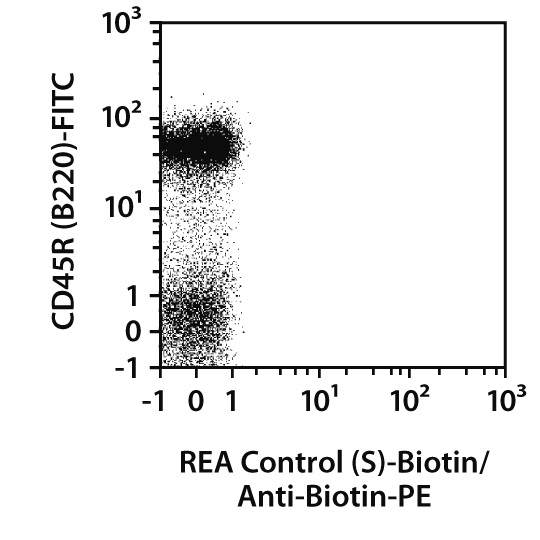Recombinant antibody
Code: 130-104-345
Overview
Clone REA153 recognizes the threonine residue (T310)-phosphorylated form of p120 Catenin, a prototypic member of subfamily of Armadillo-domain (ARM) proteins. p120 ARM domain displays 22% homology to other ARM-domain proteins such as β-catenin and plakoglobin, which are basically cadherin binding proteins, suggesting the involvement of p120 in binding to cadherin. p120 associates with most classical (type I) and nonclassical (type II) cadherins via ARM repeats 1–7 and is localised at the cell junctions, where it constitutes the cadherin complex. Functions of p120 include regulation of stability of cadherins and modulation of activity of rho GTPases in the cytoplasm. Furthermore, lack of p120 Catenin in mouse leads to tumor development, suggesting its further role as tumor supressor. Phosphorylation of p120 Catenin at multiple sites regulates its various functions and it can be phosphorylated by Src and various receptor tyrosine kinases.
Additional information: Clone REA153 displays negligible binding to Fc receptors.
Alternative names
CTNND1, CAS, CTNND, p120cas, p120ctn, p120, Catenin δ-1Specifications
- Human : 0
- PE : 0
- 30 tests : 0
- 0.3 ml : 0
- Recombinant Human IgG1 : 0
Code: 130-104-601
Overview
Clone REA316 recognizes the human CD100 antigen, a single-pass type I membrane protein which is also known as semaphorin-4D (SEMA4D). CD100 is strongly expressed in skeletal muscle, and at lower levels in testes, brain, kidney, small intestine, prostate, heart, placenta, lung, and pancreas. In the immune system, it is present on peripheral blood lymphocytes, spleen, and thymus, especially interfollicular T cells and B cells in the germinal centers of secondary lymphoid follicles. CD100 is an axon guidance molecule which is secreted by oligodendrocytes and induces growth cone collapse in the central nervous system. By binding plexin B1 receptor it functions as an R-Ras GTPase-activating protein and repels axon growth cones in the central nervous system. In the immune system, CD100 plays a critical role by turning off negative signaling by CD72 and significantly enhancing the effects of CD40 on B cell and dendritic cell responses. During skin damage repairs, SEMA4D interacts with plexin B2 on gamma delta T cells to play a role in the healing process.
Additional information: Clone REA316 displays negligible binding to Fc receptors.
Alternative names
SEMA4D, M-sema-G, SEMAJ, coll-4, A8, BB18, GR3Specifications
- Human : 0
- PE : 0
- 100 tests : 0
- 1 mL : 0
- Recombinant Human IgG1 : 0
Code: 130-104-673
Overview
Clone REA316 recognizes the human CD100 antigen, a single-pass type I membrane protein which is also known as semaphorin-4D (SEMA4D). CD100 is strongly expressed in skeletal muscle, and at lower levels in testes, brain, kidney, small intestine, prostate, heart, placenta, lung, and pancreas. In the immune system, it is present on peripheral blood lymphocytes, spleen, and thymus, especially interfollicular T cells and B cells in the germinal centers of secondary lymphoid follicles. CD100 is an axon guidance molecule which is secreted by oligodendrocytes and induces growth cone collapse in the central nervous system. By binding plexin B1 receptor it functions as an R-Ras GTPase-activating protein and repels axon growth cones in the central nervous system. In the immune system, CD100 plays a critical role by turning off negative signaling by CD72 and significantly enhancing the effects of CD40 on B cell and dendritic cell responses. During skin damage repairs, SEMA4D interacts with plexin B2 on gamma delta T cells to play a role in the healing process.
Additional information: Clone REA316 displays negligible binding to Fc receptors.
Alternative names
SEMA4D, M-sema-G, SEMAJ, coll-4, A8, BB18, GR3Specifications
- Human : 0
- PE : 0
- 30 tests : 0
- 0.3 ml : 0
- Recombinant Human IgG1 : 0
Code: 130-104-351
Overview
Clone REA301 recognizes the mouse CD101 antigen, a type I transmembrane glycoprotein also known as immunoglobulin superfamily member 2 (IgSF2) or V7. CD101 is expressed on monocytes, granulocytes, dendritic cells (DCs), and activated T cells. In humans CD101 inhibits the proliferative response of T cells to allogeneic cells or immobilized anti-CD3 antibody, suggesting that engagement of CD101 can antagonize TCR/CD3-mediated lymphocyte activation. Moreover, human peripheral CD8
+
T cells that express CD101 and CD103 display suppressive function after activation with intraepithelial cells or placental trophoblasts. In addition to its role on T cells, triggering CD101 on human cutaneous DCs inhibits T cell proliferation via interleukin 10 (IL-10) production, suggesting that the CD101 molecule may be involved in tolerance induction. Studies in mice showed that cell surface expression of CD101 is highly correlated with functional suppressor activity within CD4
+
CD25
+
T regulatory cells both
in vitro
and
in vivo
.
Additional information: Clone REA301 displays negligible binding to Fc receptors.
Alternative names
EWI-101, Gm1016, Gm734, IGSF2Specifications
- Biotin : 0
- Mouse : 0
- 60 tests : 0
- 9 µg in 300 µL : 0
- Recombinant Human IgG1 : 0
Code: 130-104-697
Overview
Clone REA228 recognizes the extracellular part of the membrane-bound and truncated soluble form of the mouse CD120b antigen, a 75 kD type I transmembrane protein, which is also known as Tumor Necrosis Factor Receptor Type II (TNF-RII). CD120b is a receptor with high affinity for the mouse cytokine TNF-α and with lower affinity for LT-α. It belongs to the TNF receptor superfamily and is largely confined to cells of the immune system. CD120b is strongly expressed on stimulated T and B lymphocytes and on a variety of cells at low levels. Sustained activation of TNF signaling has been implicated in the pathogenesis of a wide spectrum of diseases, including cancer, osteoporosis, sepsis, diabetes, and autoimmune diseases such as multiple sclerosis, rheumatoid arthritis, and inflammatory bowel disease. Additional information: Clone REA228 displays negligible binding to Fc receptors.
Alternative names
TNFRSF1B, Tumor necrosis factor receptor 2 (TNF-R2), Tumor necrosis factor receptor type II (TNF-RII, TNFR-II), p75, p80 TNF-alpha receptorSpecifications
- Human : 0
- PE : 0
- 200 tests : 0
- 30 µg in 1 mL : 0
- Recombinant Human IgG1 : 0
Code: 130-104-487
Overview
Clone REA282 recognizes the human CD147 antigen, a single-pass type I membrane protein which is also known as basigin (BSG) or extracellular matrix metalloproteinase inducer (EMMPRIN). CD147 is expressed by many cell types, including epithelial cells, endothelial cells, leukocytes, and tumor cells. It is present in vascular endothelium in non-neoplastic regions of the brain and in tumor cells, but not in proliferating blood vessels in malignant gliomas. CD147 has been implicated in a variety of physiological and pathological activities. It is best known for its ability to function as extracellular matrix metalloproteinase inducer, but has also been shown to regulate lymphocyte responsiveness, monocarboxylate transporter expression, and spermatogenesis.
Additional information: Clone REA282 displays negligible binding to Fc receptors.
Alternative names
BSG, 5F7, EMMPRIN, M6, OK, TCSF, OK blood group antigen, Tumor cell-derived collagenase stimulatory factor (TCSF)Specifications
- Human : 0
- Biotin : 0
- 100 tests : 0
- 1 mL : 0
- Recombinant Human IgG1 : 0
Code: 130-104-536
Overview
Clone REA282 recognizes the human CD147 antigen, a single-pass type I membrane protein which is also known as basigin (BSG) or extracellular matrix metalloproteinase inducer (EMMPRIN). CD147 is expressed by many cell types, including epithelial cells, endothelial cells, leukocytes, and tumor cells. It is present in vascular endothelium in non-neoplastic regions of the brain and in tumor cells, but not in proliferating blood vessels in malignant gliomas. CD147 has been implicated in a variety of physiological and pathological activities. It is best known for its ability to function as extracellular matrix metalloproteinase inducer, but has also been shown to regulate lymphocyte responsiveness, monocarboxylate transporter expression, and spermatogenesis.
Additional information: Clone REA282 displays negligible binding to Fc receptors.
Alternative names
BSG, 5F7, EMMPRIN, M6, OK, TCSF, OK blood group antigen, Tumor cell-derived collagenase stimulatory factor (TCSF)Specifications
- Human : 0
- Biotin : 0
- 30 tests : 0
- 0.3 ml : 0
- Recombinant Human IgG1 : 0
Code: 130-104-638
Overview
Clone REA299 recognizes the mouse CD150 antigen, a 75-95 kD single-pass type I membrane protein also known as signaling lymphocyte activation molecule (SLAM). CD150 belongs to the immunoglobulin superfamily and acts as a self ligand. Expression of CD150 is found on B cells, dendritic cells and activated/memory T cells. It is involved in functions such as stimulation, proliferation and inhibition of apoptosis of B cells, stimulation and IFN-γ production in Th1 T-cell clones and recently it has been identified as the second receptor for measles virus. In combination with CD48 and CD244, CD150 is a useful marker for hematopoietic stem cell studies.
Additional information: Clone REA299 displays negligible binding to Fc receptors.
Alternative names
SLAMF1, CDw150, ESTM51, IPO-3, SLAMSpecifications
- Biotin : 0
- Mouse : 0
- 200 tests : 0
- 30 µg in 1 mL : 0
- Recombinant Human IgG1 : 0





